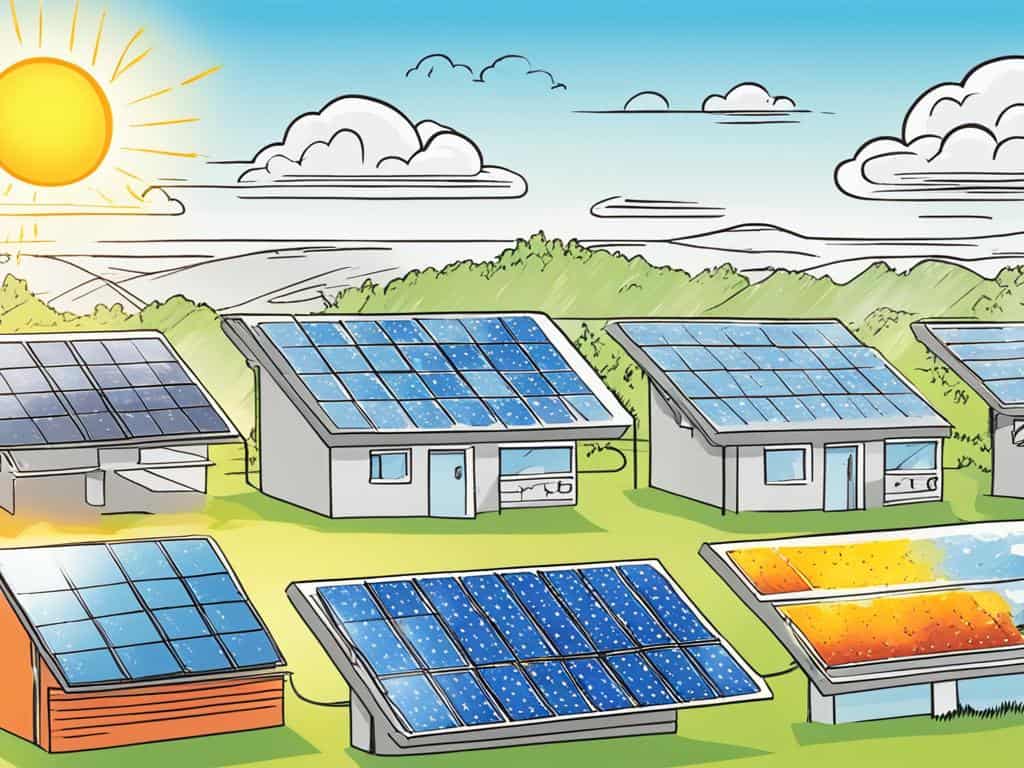Understanding Solar Flux: The Key to Efficient Solar Energy
Explore the essentials of solar flux and unlock the potential for high-efficiency solar energy production in India’s vibrant renewable power landscape.

India is making strides towards better solar energy, focusing on something crucial yet often missed: solar flux. This is essentially the sun’s power and is vital for achieving high efficiency in renewable energy. With India’s big goals in solar power, knowing all about solar flux is more important now than ever.
At the core of converting sunlight to energy is a key question. How can accurately measuring this solar power take India’s solar abilities to the next level? Fenice Energy, with over twenty years of experience, leads the way. They offer custom solar solutions that make the most out of solar flux for homes and businesses.
Key Takeaways
- Defining solar flux and its significance in the realm of efficient solar energy production.
- The formula behind calculating the solar radiation that Earth receives, and its implication for solar power technology.
- Exploring the spectral changes due to atmospheric interactions and their impact on renewable energy in India.
- Investigating the challenges and opportunities in harnessing solar flux to better serve India’s growing demand for renewable energy.
- The role of precision in solar flux measurements for enhancing the efficiency of solar panels.
Demystifying Solar Flux in Solar Energy Harvesting
The intricate dance of photons cascading from our star is a spectacle. When measured and understood carefully, it becomes the power behind solar energy. The collection of solar flux, or solar irradiance, tells us the energy received per unit area. It is vital for evaluating and boosting the power of photovoltaic cells in India.
In India, solar radiation is a rich source for clean energy. Solar flux measurements let innovators at Fenice Energy shine in capturing this energy. Capturing sunlight accurately involves knowing how solar radiation is affected. Factors include the angle of rays and how light interacts with dust and water vapor.
- Latitude impacts the angle of solar light, changing how much energy we get.
- The time of year affects sunlight’s duration and quality.
- Clouds, pollution, and humidity change how much solar energy reaches us.
Harvesting solar energy isn’t just about capturing sunlight. For Fenice Energy, it means turning that sunlight into sustainable power. Sunlight is valuable, but so is the light from scattered sunlight. This comes from clouds and gives extra light for days without direct sun.
In India, aiming for a green energy framework is a goal. Using both direct and scattered solar radiation ensures steady solar energy. Photovoltaic cells are optimized to get the most energy, no matter the solar flux conditions. This is key for India’s energy independence and green efforts.
Fenice Energy focuses on using natural resources and advanced technologies. This effort supports India’s growing solar sector. As solar flux measurements improve, so does the chance for energy systems powered by our abundant star. Every ray of sunshine tells the story of solar power—a tale of energy, endurance, and boundless opportunities.
Impacts of Atmospheric Interactions on Solar Flux
The quest to boost solar energy significantly leans on understanding atmospheric effects on solar radiation. Fenice Energy emphasizes these factors to increase solar panel efficiency. To grasp the complexity, one must explore how solar radiation is scattered and absorbed.
The Role of the Atmosphere in Modulating Solar Radiation
Solar radiation meets many atmospheric conditions on its way to Earth. Clouds, particulates, and water vapor can reduce solar flux by 15-80%. This is key for designing solar panels, as differences in transmissivity rates globally and seasonally are crucial for energy optimization.

Understanding Scattering and Absorption of Solar Radiation
The atmosphere’s scattering of solar radiation impacts the sunlight’s quality. Rayleigh’s law explains that shorter wavelengths scatter more. This complicates designing systems that capture a wide spectrum of solar radiation. Also, gases like oxygen and ozone absorb specific solar spectrum parts. This selection alters sunlight’s intensity and effectiveness for panel conversion.
To show how atmospheric interactions affect photovoltaic efficiency, consider this table. It shows different atmospheric conditions’ impacts on solar panel output:
| Atmospheric Condition | Impact on Solar Radiation | Effect on Solar Panel Output |
|---|---|---|
| Clear Skies | Maximum sunlight reaches the surface. | Optimal power generation. |
| Cloud Cover | Reduces solar radiation; increases diffuse light. | Reduction in output but diffuse-tolerant panels can still perform. |
| Particulates (Dust, Smog) | Scattering and absorption of light. | Variable impact; may necessitate more frequent cleaning. |
| Atmospheric Gases (Ozone) | Selective absorption of wavelengths. | Reduced efficiency in standard panels; potential for specialized photovoltaic materials. |
The changing atmospheric conditions highlight the need for creative solar panel design and energy system improvements. Fenice Energy is aiming for a future where solar energy in India is more sturdy and effectively used.
The Significance of Solar Flux for Photovoltaic Cells
In India’s solar power industry, understanding solar flux is critical. Solar flux is the flow of solar radiation important for photovoltaic cells’ output. Maximizing solar panel efficiency depends on understanding solar flux variability. This knowledge is key to developing efficient solar systems for India’s unique conditions.
Maximizing Solar Panel Efficiency through Flux Understanding
Fenice Energy aims to boost photovoltaic cells to peak performance. The efficiency of these cells closely links to the solar radiation they get. Despite challenges with solar flux variability, Fenice uses precise strategies to maximize energy production. This approach has built their reputation for innovative and reliable solar solutions in India.
Technological Advances Influenced by Solar Radiation Metrics
India’s solar power industry is evolving with solar technology advances. These advances stem from deep research into solar radiation metrics. Fenice Energy uses the latest technologies for stronger photovoltaic cells. They suit India’s climate and diverse solar radiation profiles. These advances help make solar power systems more durable and productive nationwide.
Solar Flux: The Key to Efficient Solar Energy
Solar flux is more than just numbers—it’s the heart of India’s solar market. It’s key to the success of clean energy there. Fenice Energy, a leader in clean energy solutions for Indian homes, knows this very well.
India has a huge potential for renewable energy. This is thanks to its geography, which gives it lots of sunlight. But, understanding solar flux data is crucial. It’s not just about how much solar energy. It’s about knowing how changes in time and weather affect solar radiation.
The appeal of efficient solar energy is obvious. It’s not only plentiful but also good for the planet. The growth of India’s solar market depends on using solar flux data well. Fenice Energy uses this data to bring top-notch solar solutions to Indian rooftops.

Solar flux affects how solar panels work. For example, solar irradiance changes can influence a panel’s output. This means panels must be placed strategically. Adaptation is key to capturing more energy, anytime.
Here’s how solar flux data is essential:
- It helps with finding the best angle for panel setup.
- It’s used to check weather conditions that affect energy output.
- It guides the design of solar systems for different locations.
Companies like Fenice Energy use this detailed info to lead in renewable technology. This drives innovation and helps create efficient solar solutions for India.
In summary, solar flux is crucial for renewable energy. India is at the edge of a solar breakthrough. Fenice Energy leads this effort with strong solar flux data and support for sustainable energy.
Influence of Location and Environment on Solar Power Generation
In India, the success of solar power highly depends on geography and weather. These factors affect how much sunlight reaches the solar panels. Understanding these elements is key for Fenice Energy to ensure their solar systems work well.
How Geographic and Climatic Factors Affect Solar Flux
India’s varied landscapes, from deserts to mountains, cause changes in solar power. These differences affect how much sunlight we get. Also, weather patterns like monsoons can create unpredictable shadows, making it tough to get consistent solar energy.
Season changes can also impact solar energy in India. For example, monsoons bring clouds that reduce power production. But dry seasons with clear skies can boost it. Understanding these patterns helps in making better solar systems that adapt to weather changes.
Strategies to Optimize Solar Energy Systems for Different Regions
To improve solar power in India’s diverse areas, specific plans are needed. Fenice Energy uses detailed maps to design systems that handle different sunlight levels. This way, they create more efficient solar solutions.
Systems also need to deal with unpredictable weather. Fenice Energy uses advanced tech to maintain efficiency despite the challenges. This improves the reliability of solar power. Each solution is made to fit the local environment and energy needs.
Fenice Energy looks at global studies to understand how solar systems affect nature. They consider the impact on wildlife and ecosystems. This approach helps them create environment-friendly solar solutions. It also supports the growth of the agrivoltaic industry in India.
Conclusion
India is moving towards a brighter future with solar energy leading the way. The solar energy revolution is here, thanks to the unique blend of sunlight that hits our planet. Fenice Energy, boasting two decades of experience, knows that this spectrum requires advanced solar flux analytics. They use cutting-edge technology to accurately measure solar power.
The growth of solar energy in India depends on smart, sustainable solutions. It’s not just about setting up panels. It involves deep knowledge of how these panels work with different light wavelengths. Fenice Energy uses this knowledge to craft systems that achieve India’s green energy targets and lead globally.
India is committed to reducing its reliance on fossil fuels by focusing on renewable energy. By studying solar radiation closely, the country is ready to tackle obstacles and grab new chances. Fenice Energy plays a key role in this journey, providing clean energy solutions for a better, greener tomorrow.


